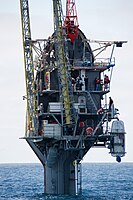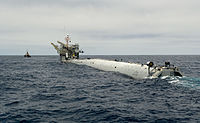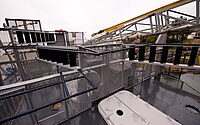RP FLIP

|
|
| History | |
|---|---|
| United States | |
| Owner | Office of Naval Research |
| Operator | Scripps Institution of Oceanography |
| Builder | |
| Cost | Approximately US$600,000 |
| Launched | 22 June 1962 |
| Completed | 23 July 1962 |
| In service | September 1962 |
| Out of service | August 2023 |
| Identification |
|
| Status | To be scrapped |
| General characteristics | |
| Type | Research platform |
| Tonnage | 700 GT |
| Length | 108 m (355 ft) |
| Beam | 7.93 m (26.0 ft) |
| Draught |
|
| Installed power |
|
| Propulsion | None |
| Speed | Towed: 7–10 kn (8–12 mph; 13–19 km/h) |
| Endurance | 35 days |
| Capacity |
|
| Complement | 5 crew, 11 researchers |
R/P FLIP (floating instrument platform) was an open ocean research platform owned by the U.S. Office of Naval Research (ONR) and operated by the Scripps Institution of Oceanography. The platform was 108 meters (355 ft) long and was designed to partially flood and pitch backward 90°, resulting in only the front 17 meters (55 ft) of the platform pointing up out of the water, with bulkheads becoming decks. When flipped, most of the buoyancy for the platform was provided by water at depths below the influence of surface waves, hence FLIP was stable and mostly immune to wave action, similar to a spar buoy. At the end of a mission, compressed air was pumped into the ballast tanks in the flooded section and the platform, which had no propulsion, returned to its horizontal position so it could be towed to a new location. The platform was frequently mistaken for a capsized ocean transport ship.
FLIP's last research cruise was in late 2017, with ONR ending its support of the vessel in 2020. It was berthed at the Nimitz Marine Facility pier (Scripps) in Point Loma until being towed away to be scrapped on August 4, 2023.
History

The Marine Physical Laboratory (MPL) of Scripps Institution of Oceanography created FLIP with funding from the Office of Naval Research and the assistance of the commercial naval architecture firm The Glosten Associates. FLIP was originally built to support research into the fine-scale phase and amplitude fluctuations in undersea sound waves caused by thermal gradients and sloping ocean bottoms. This acoustic research was conducted as a portion of the Navy's SUBROC program. Development started in January 1960 after a conversation between MPL researcher Frederick H. Fisher and MPL Director Fred N. Spiess regarding stability problems that Fisher was encountering when using the submarine USS Baya (SS-318) as a research platform. Spiess recalled a suggestion from Allyn Vine that upending a ship might make it more stable, based on Vine's observation of a Navy mop floating in waves. Fisher was subsequently assigned to work on the feasibility and later development of such a vessel. The Gunderson Brothers Engineering Company in Portland, Oregon, launched FLIP on 22 June 1962.
FLIP was used on a number of research expeditions at Scripps, often towed off shore of California, with the last cruise being September-October 2017. It was estimated that it would take $8 million USD to provide FLIP with another decade of operational life in 2021 and many of the scientific community wanted to see it become a museum piece. However, following the COVID pandemic and reduced funding, having the vessel scrapped became a much more likely scenario. On August 3, 2023, the vessel departed for a scrap yard, apart from an instrument boom which will be installed on a pier at Scripps.
Capabilities
FLIP was designed to study wave height, acoustic signals, water temperature and density, and for the collection of meteorological data. Because of the potential interference with the acoustic instruments, FLIP had no means of propulsion. It required to be towed to open water, where it drifted freely or was anchored.
FLIP was 700 gross tons. It carried a crew of five, plus up to eleven scientists. It was capable of operating independently during month-long missions without resupply. It could be operated around the world, although it normally operated off the west coast of the United States from a home base at Scripps' Nimitz Marine Facility in San Diego, California. The ship had specially designed interiors: some fixtures, such as the toilet seats, could flip 90°, and the shower heads were curved 90°. There were overhead lights on the surfaces that were the ceilings in both the towing (horizontal) and flipped orientations.
Gallery
-
Video of FLIP flipping
-
 FLIP vertical in 2012
FLIP vertical in 2012 -
 FLIP under tow in 2012
FLIP under tow in 2012 -
 FLIP in horizontal position, showing rails for vertical position
FLIP in horizontal position, showing rails for vertical position


